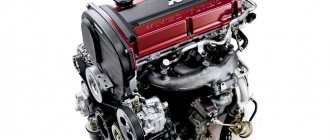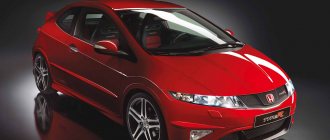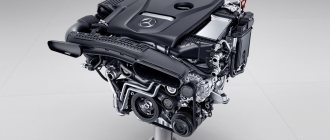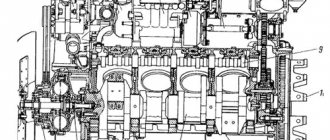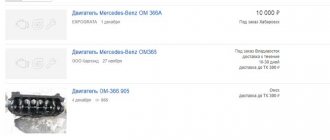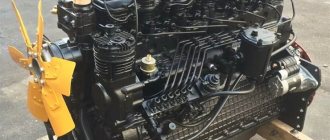The B2 diesel engine is a 12-cylinder, four-stroke diesel power unit, which is designed specifically for use in tanks. This engine appeared during wartime and subsequently remained on the assembly line for a long time, and on its basis various units were manufactured that were widely used on trucks and heavy special equipment. Even today, after more than 50 years since the start of production, modifications of this power unit are still on the assembly line and are manufactured at the Ural Motor and Chelyabinsk Tractor class=»aligncenter» width=»1136″ height=»466″[/img]
Specifications
Download .xls file
xls
Download picture
Send by email
| OPTIONS | MEANING |
| Years of manufacture | 30s |
| Engine weight, kg | 874 |
| Cylinder block material | aluminum |
| Supply system | direct injection |
| Type | V-shaped (at an angle of 60°) |
| Working volume, l | 38.8 |
| Power (at 1800 rpm), l. With. | 500 |
| Number of cylinders | 12 |
| Number of valves | 48 |
| Piston stroke, mm | 180 in the left group and 186.7 in the right |
| Cylinder diameter, mm | 150 |
| Compression ratio | 14 (15) |
| Max torque, Nm at 1200 rpm | 1960 |
| Fuel | diesel |
| Fuel consumption, l | Hourly fuel consumption 4.5 |
| Oil | Diesel mineral oil |
| The oil change is carried out | 200 |
| Engine life, thousand km | |
| - according to the plant | 15,000 engine hours |
| - on practice | 15,000 engine hours |
The B2 series engine and its modifications are installed on T-34, BT-7M, KV-1, KV-2 tanks.
V-2 engine design
Volume 38.8 liters, compression ratio 14 and 15. Rated engine power was 450 hp. at 1750 rpm, operational - 400 hp. at 1700 rpm, maximum - 500 hp. at 1800 rpm. Engine weight is about 1000 kg. Cylinder diameter 150 mm. The piston stroke of the left group is 180 mm, the right one is 186.7 mm. The cylinders were arranged in a V-shape at an angle of 60°.
Initially, the engine was developed for use in aviation - on heavy bombers. This circumstance determined some design features of the diesel engine, uncharacteristic for engines of land vehicles, and determined the very high technical perfection of the engine. Among them:
- lightweight design with extensive use of light alloys (however, in the middle of the war, due to a lack of aluminum, it was necessary to temporarily replace silumin with cast iron);
- overhead camshafts, two in each engine head (DOHC);
- 4 valves per cylinder;
- dry sump;
- direct fuel injection, jet mixture formation;
- drive of all engine units and systems via bevel gears and intermediate inclined shafts;
- the use of steel studs as the main force element for tightening the head, cylinder block and crankcase.
However, it was not possible to bring the power to the requirements of aviators (1000-1500 hp) even by using supercharging, and the engine design was adjusted for installation on tanks.
Description
The development of a water-cooled power unit with jet fuel atomization began in the thirties of the last century at the Kharkov Locomotive Plant.
The new engine was planned to be used first on airplanes and then on heavy tanks, so increased demands were placed on the power unit. Initially, specialists from the Kharkov Steam Locomotive Plant produced a single-cylinder engine, and subsequently a 12-cylinder powerful diesel engine with a volume of 38.8 liters was made from such individual elements. The power ratings of this power unit in the basic version were 500 horsepower. Such power was enough for heavy tanks, river boats and other extremely heavy equipment.
Excellent performance characteristics were achieved through the use of a four-valve arrangement for each cylinder, innovative for those times. This made it possible to ensure high-quality combustion of the fuel-air mixture, and the engine itself worked smoothly, providing tanks and heavy equipment with the necessary thrust.
The use of aluminum for the manufacture of the cylinder head and cylinder block is also a non-standard solution for the middle of the last century. This made it possible to significantly lighten the motor, ensuring its strength and resistance to temperature deformation.
The engine has a dry sump and an overhead camshaft. Each engine head has two of these camshafts. Direct fuel injection can significantly improve the output of the power unit and simplifies the subsequent use of the engine. Despite its power indicators and record displacement characteristics, this power unit turned out to be compact, which made it possible to install it on small-sized light tanks.
One of the requirements for this power unit is its reliability and ease of repair and maintenance. Tank engines are subject to the maximum possible load during operation, so such a motor must be reliable and easy to maintain. Most of the systems, including the fuel system, are duplicated in this engine, which allows the engine to function even in the event of serious breakdowns, ensuring the necessary use of the equipment.
Alternative to tank diesel V-2
Home » Alternative History » Alternative History (fiction of this genre) » Alternative to the V-2 tank diesel
Alternative History (fiction of this genre)Alternative tank building
Hoplite 09/25/2019 2526
17
in Favoritesin Favoritesfrom Favorites 5
At the moment I am reading another work about a newcomer to the pre-war USSR, “Marshal” by Mikhail Lantsev , this time an introduction to Marshal Tukhachevsky in 1935, the work contains interesting reflections about the V-2 tank diesel engines, I bring them to your attention.
Tank diesel V-2
October 22, 1938. Moscow region. Stalin's nearby dacha The last working meeting before a long business trip to Czechoslovakia somewhat worried the marshal. I really didn’t want to let many questions go to chance because of fears of the very wood that inquisitive minds could break at any moment without supervision. All that was left was to believe and hope for success. However, this meeting could not be called quick and simple, since in connection with the problems in Czechoslovakia, the issue of preparing the Red Army in particular and the USSR in general for the upcoming war arose even more acutely.
Stalin needed to keep this issue under control, and therefore, for the umpteenth time, the bones of the “pieces of iron” were thoroughly washed out. However, we started off somewhat on the wrong foot, since the issue of intensifying work on tank diesel engines with the goal of transferring the majority of the fleet of armored forces to it before the war arose once again. Someone very persistently in the leadership of the USSR wanted to promote the diesel engine into the tank fleet at any cost, no matter what, coming from one side or the other.
Mikhail Nikolaevich was at a loss regarding these lobbyists, since he could not calculate why this was being done. Probably, the next “red directors” with “three classes of a parochial school” and “revolutionary universities” behind them, by the will of fate, who find themselves in high positions are again muddying the waters. But the marshal was already accustomed to such “frames”, trying not to make sudden movements and work patiently.
“Comrade Tukhachevsky,” Molotov asked, “I don’t really understand your attitude towards diesel engines.” A number of comrades in the commanding staff of the Red Army believe that you are deliberately overwriting this promising solution, which would make it possible to seriously increase the power supply of Soviet tanks and increase their range with the same amount of fuel.
— Diesel engines are, of course, a very important area and the transition to them in the Armored Forces is not only necessary, but also inevitable, because their efficiency and traction, especially at low speeds, and unpretentiousness in operation simply have no competition.
— Then why do you so consistently advocate the use of gasoline engines in promising tanks? — Molotov was sincerely surprised.
— Because compact tank diesel engines are a leading technology.
- What? - Kaganovich asked. — What does advanced technology mean? What is she ahead of?
“If briefly and without going into details, then the current technological level,” Tukhachevsky answered calmly.
- What if we go into details? - Molotov, who did not really understand anything, asked again.
- Hm. “The marshal thought for a few seconds. — I’ll try to explain clearly. Currently, the BT-7 and T-28 tanks are powered by the M-17-T gasoline engine. It costs us about seventeen thousand rubles, and the guaranteed service life of this unit before major repairs is around two hundred and fifty hours of operation in the tank. There are up to four hundred on the stand. According to the estimates given to us at the Research Institute of Engine Engineering, we can get a tank diesel, including on an industrial scale, but in this case it will be twice as heavy as gasoline, even with the active use of light alloys such as silumin in its design. In addition, its production cost will be estimated at least three times more than the very low-tech M-17-T engine, while its service life in the tank will be something like fifty hours, after which it will require a major overhaul, which will also turn out to be expensive. It is not difficult to calculate that for one M-17-T engine, taking into account two major overhauls, it will be necessary to replace five diesel engines that have undergone two overhauls each to obtain a similar number of hours of engine life. Is fifty hours of service life a lot or a little? This is a march of three hundred to four hundred kilometers, not in a straight line, but with some downtime under idle speed and maneuvers. And after such a short mileage, it will be necessary to massively overhaul diesel engines at the forefront, or change them altogether. Immediately at the entire armored unit, which because of this will be practically paralyzed. I don’t think it’s the right decision to get an expensive engine that can’t even replace a cheap gasoline one. But bringing the M-17 to fruition and making it not an aviation engine, but a purely tank engine is much easier and faster than “giving birth” to even just a semi-edible tank diesel engine. Look, work on the B-2 is still going on with very modest success.
- And why is this happening? - Voroshilov asked.
— Due to the fact that a diesel engine experiences significantly more severe internal loads than a gasoline engine. In the case of a ship or tractor diesel engine, the issue of dimensions and weight is not so acute, so it turns out to scale the engine, significantly reducing the specific power per unit volume and thereby reducing the overall internal loads. In the case of a modern tank diesel engine, it will not be possible to get out so easily. Due to the high compactness, significantly greater demands are placed on the quality of materials and their processing. Therefore, the destruction of the same piston group occurs much faster than in the case of gasoline. That is, we can make a tank diesel, but does that make sense? We currently have neither the materials nor the processing technologies that would allow us to make a tank diesel engine of at least satisfactory quality and reliability. And the very benefit of using a diesel engine in a tank turns out to be completely ephemeral, since an attempt to save on fuel and get slightly better traction forces will most decisively hit the strategic maneuverability of armored units, the training of personnel who will be desperately short of hours, and so on . This state of affairs is called advanced technology, when it is already possible, but it is still too early.
A separate technical article from the same work. M-17 vs V-2. Evaluation and conclusions
In Russian historiography, there is a common opinion that the V-2 engine was a breakthrough in the field of tank building, which allowed the USSR to make a serious leap forward. Let's look at this issue in more detail. Motor life By the end of 1936, the motor life of the M-17-T reached 400 hours on the stand, 250 hours in the tank. By March 1941, the service life of the V-2 reached 100 hours on the stand, 50 hours in the tank. Purchase prices In 1940, the M-17 was estimated at 19,000 rubles (although there is information about 17 thousand). In 1940, the B-2 was valued at 61,700 rubles. Considering the fact that purchase prices in 1940 in the USSR were far from market prices, but were based on technological features, we can conclude that in 1940 the M-17-T engine was 3,247 times cheaper to produce than the engine AT 2. That is, if we take into account that the guaranteed service life of the M-17-T was determined to be 250 hours, and that of the V-2 diesel engine was 50 hours, then to ensure equal mileage of the armored tank fleet, 5 times more V-2 diesel engines are needed. I agree, this is not yet manufacturability, but the productivity of factories has already been consumed. If we add to this fact the peculiarity that the V-2 cost 3,247 times more than the M-17-T gasoline engine, then we could say that a certain conventional engine plant on the same equipment park could provide with the help With M-17-T engines, the total mileage of the armored tank fleet is 16.2 times greater than that produced by the V-2 diesel engine.
Engine M-17-T
Now let's move on to the cost of repairs. According to the V-2 diesel engine, there is no data on major overhauls, however, there is an article 'Major overhaul of the M-17' and in the column 'Price per unit. (RUB)' three values are given: 7239, 8000 and 11529 - or 38, 42 and 61% of the original price of the new motor. Taking this ratio as a guide and applying it to the V-2 engine, we get 23,500, 26,000 and 37,500 rubles for each repair. These are the costs of the first, second and third major repairs. Thus, it turns out that with a full operating cycle of the M-17-T engine, taking into account three major overhauls, it will go through 750 hours and will cost 49,297 or 65.73 rubles for each hour, while the full life cycle of the B-2 will be on average 150 hours and will cost 148,700. At the same time, to provide those 750 hours, 5 V-2 engines will be required with a total operating cost of 743,500 rubles or 991.33 rubles for each hour. Well, 3 major repairs versus 9.
There is an opinion that overhaul of the B-2 was cheaper. But in reality this is not the case, since during the overhaul they changed the liners and piston group, which were very expensive due to the need to withstand heavy loads. After all, it was they who fell apart in the first place on the V-2 tank diesel engines. In my opinion, the equation between M-17-T and V-2 in the cost of major repairs is a big nod in favor of diesel. It is likely that its repair was significantly more expensive.
Now let's move on to fuel consumption. Fuel consumption of the M-17-T (throttled) is 250-290 grams per hp. at one o'clock. V-2 fuel consumption is 160-175 grams per hp. at one o'clock. Let's take the maximum values of 290 and 175 grams per hp. per hour and let’s assume that this consumption was at standard operating capacities, which are the same for the M-17-T and V-2 and amount to 400 hp. Thus we get 116 and 70 kg of fuel per hour. Above we talked about 750 hours of standard operation of the M-17-T (including two overhauls). We will be guided by them and will receive 87 tons of Baku gasoline of the 2nd grade for the M-17-T gasoline engine for the full cycle of its operation (with two overhauls) and 52.5 tons of diesel fuel for 5 V-2 diesel engines for the full cycle their operation (with two overhauls). The fuel economy is obvious - 34.5 tons. But will it be able to compensate for the difference in engine costs?
I did not find any materials about what “Baku 2nd grade gasoline” is. Moreover, in the manuals themselves they write that this is just gasoline, not aviation gasoline. Stupidly and directly “Baku gasoline of the 2nd grade” - here is a fragment from the BT-7 manual, so as not to cause Link to “seething shit”. I found out what “Baku 1st grade gasoline” is - cracked gasoline with an octane number of 70-73. That is, the same KB-70. Apparently, the 2nd grade is something worse. For example, with an octane number of 65-66. However, the M-17-T engines also worked quite well on the KB-70, so we will focus on it. The cost of 1 liter of KB-70 is 0.91 rubles, and DT diesel fuel is 0.38 rubles. Thus, the total cost of fuel for the M-17-T for its entire operating cycle is 105,560 rubles, and for five V-2s, respectively, 23,470 rubles. The difference turns out to be even more significant.
Let's summarize the total estimate and get 154,857 rubles for 750 hours on the M-17-T (1 engine with two overhauls), and 766,970 rubles for 750 hours on the V-2 (5 engines with two overhauls each). Or 206 rubles per 1 engine hour for the M-17-T and 1022 rubles per 1 engine hour for the V-2. That is, the transition to tank diesel will lead to an increase of more than 5 times each engine hour, which will most decisively impact not only the strategic mobility of troops, but also the training of personnel, since, all other things being equal, the cost of practice will increase accordingly. What kind of training do tankers have without extensive practice - running in a variety of conditions? But maybe they did this out of despair? Suddenly there was not enough fuel at all and they tried to get out of it this way. And here the question arises, a well-known question related to the classics of the fuel balance. Supporters of this version believe that the use of the V-2 diesel engine made it possible to save armored forces from fuel starvation. Is it so? Let's look at the dynamics of liquid fuel production in the USSR during the war years (in thousands of tons).
Motor fuel is, apparently, a variety of gassols.
As can be seen from the table, the balance of fuel production in the USSR indicated a seriously reduced level of diesel fuel production compared to gasoline. But this does not show the situation as a whole, because these are only producers. Therefore, we turn to the 1941 mobilization plan for liquid fuel consumption. Here is the 1941 Mobilization Plan for liquid fuel without taking into account the fleet (in tons).
From this table the following proportion is clear:
- aviation gasoline (B-78, B-74, B-70, RB-70 and KB-70) - 3,161,486 tons; - motor gasoline - 4,659,883 tons; - diesel fuel and oils (excluding aviation oil) - 2,439,996 tons; - kerosene - 543,552 tons; - aviation oils - 38,516 tons.
Now let's look at the decline in fuel production during the war years (with percentages expressing a share of 1941 production). For comparison, the indicators of the 1941 Mobilization Plan are shown.
One glance at the table is enough to understand what dynamics were observed in the provision of the Red Army and the Soviet Union with various types of liquid fuel. But the situation was further aggravated by the fact that at the end of 1941, it “turned out” that, in addition to the armed forces, fuel was also consumed in other people’s commissariats of the USSR.
In reality, for ground troops, the need for fuel was satisfied by KB-70 and B-59 by 82.5%, by gasoline by 62%, and by diesel fuel by 45.3%. That is, the most favorable situation was with the provision of fuel to light tanks T-26 and BT. At the same time, the rearmament of the army with new types of tanks with diesel engines - KV, T-34, T-50 - was not adequately provided with fuel. The situation was similar with the huge fleet of diesel tractors, which, according to the Mobilization Plan, were attracted from the national economy for the needs of the Red Army with the outbreak of hostilities.
Things were no better in the NKVMF and NKVD. In other words, the supply of the armed forces of the Soviet Union did not meet the needs for any type of liquid fuel. Fortunately, in the Third Reich things were even worse in absolute numbers, even despite very significant help from the USSR's "allies" in World War II.
Based on the above information, two conclusions can be drawn:
Firstly, the supply of liquid fuel in the USSR was not sufficiently implemented in general, for all types of fuel, except for kerosene and fuel oil. But this is a common problem.
Secondly, talk that the beginning of the conversion to diesel fuel before the war of the armored forces of the Red Army became a salvation from fuel hunger is a delusion. It was not possible to escape from fuel hunger at all, not for any type of fuel. However, diesel fuel, along with high-octane aviation gasoline and aviation motor oils, was the most scarce type of fuel and lubricants throughout the war.
That is, there was not enough diesel fuel. On the contrary, it was in severe shortage.
Thus, it can be stated, no matter how regrettable it may be, but the “standard”, “most modern, reliable and powerful” diesel engine V-2 was the combat, economic, operational and production “anchor” not only of the tank building of the USSR in 1938-1941, but also the Red Army, seriously complicating the training of personnel due to the colossal increase in each operating engine hour. And later, during the hostilities of 1941-1945, it most decisively hampered the maneuver and operation of combat vehicles with its extremely low engine life and high cost.
///This information about fuel supply is taken from the Russian State Archive of Economics. Fund 4372. Inventory 92. File 261. Sheets 112-113.
But there is no need to assume that the M-17 was ideal. No. It also had disadvantages, for example, the lack of a single cylinder block seriously complicated the adjustment of the engine after initial assembly or major overhaul. Therefore, it was necessary to create a new engine. But not the radically crude and extremely expensive V-2, but to modernize the M-17, giving it the same solid cylinder head, and continue work on the diesel engine and not switch to it until it is possible to create something really sensible. And here it should be noted that the successors of the B-2 were able to achieve similar qualities inherent in the M-17 only in the early 50s in the famous T-54 diesel engine. That is, the designers needed more than twenty years of their own scientific research to create a digestible tank diesel engine.
A short note on aviation gasoline. The USSR supplied quite a decent amount of gasoline through Lend-Lease, but firstly, it was exclusively for aviation, and secondly, almost all of it had a high octane number, being a product primarily of catalytic cracking, which made it possible to obtain pure gasoline with an octane number of 80-82 and on its basis make an aviation one with 100-110 points.
Help
In order to stop some pointless disputes, I present a summary table of engines
* With flat pistons, the compression ratio of the M-5 engine is 4.7-4.8, and the power at the same speed is 365 hp.** In the first series of M-17-T engines, the compression ratio was 5.3* ** Highway driving on wheels*** Dirt road driving on tracksTorque for standard operating power is calculated. Formula M = 10000 N / (1.046 n) where - M - torque, N - power in kilowatts, n - speed in revolutions per minute.
What is M-17-Td?
This is a throttled version of the M-17F aircraft engine. What is throttling? This is a depletion of the fuel-air mixture with fuel itself. Why is this being done? To reduce the overall load on the engine. Why was this solution used in the M-17-T? Because for quite a long time the tanks were powered by M-17F aircraft engines that were killed to hell and restored, which were already so worn out that they could no longer operate more or less stably without depowering due to throttling. That is, having killed the M-17-T, which was specially created and not transferred after wear and tear from aviation, it could be restored, throttled and used again. How was the M-17-T throttled?
Here is a selection from the source:
The unthrottled engine has a maximum power of 700 hp. and maximum torque 320 kgm.
To limit power and torque: a) a gasket with a hole diameter of 40 mm is installed in the carburetor diffuser; b) the valve timing is shifted by 35 degrees towards the intake delay, while the engine power at a speed of 1650 per minute is 380-400 hp ., and torque - 160 kgm, maximum torque at 850-900 rpm 220 kgm;
That is, it turns out that on the M-17-T (throttled) they not only depleted the mixture, but also shifted the ignition very seriously so that the overall load would not destroy the heavily worn engines. Which, by the way, is why sparks flying out of the engine exhaust pipes are observed at night on the M-17-Td. Not on the M-17-T and not on the M-17, but on the throttled M-17-T. This step was, apparently, a forced measure, which led not only to engine overheating (since fuel combustion occurred not in the cooled cylinder head, but outside it - in the exhaust manifolds), but also to a number of other shortcomings. An unsuccessful solution, in general (ignition offset by 35 degrees), it would be better to lean the mixture more or reduce the compression ratio due to the shape of the pistons.
This point is especially bad because it only takes insufficient skill or malice to shift the ignition even further, which was done during the 1939 test in order to demonstrate the wretchedness of the M-17-T. It is likely that the tests were carried out on a restored, throttled version with the ignition very much shifted, which led to severe overheating, a drop in power and excessive fuel consumption.
The list of information about engines and operational characteristics is very banal - these are operating manuals.
— Instruction for the armored forces of the Red Army. Tank BT-5. Moscow. 1935.- Instruction for the armored forces of the Red Army. Book one. Part 1. Materials, driving, care and adjustment of the T-28 tank. Issue 10. Moscow-Leningrad. 1935.- Instruction for the armored forces of the Red Army. Tank BT-7. Moscow. 1938.- Tank KV. Service manual. Moscow. 1941- Tank T-34. Management. Second edition, revised. Moscow - 1944.
Links:
https://samlib.ru/l/lancow_m_a/marshal_m-17_b-2_fight.shtml/
https://samlib.ru/m/marishin_m_e/
Modifications
During the operation of this power unit and its presence on the assembly line, several modifications were produced, which differed in their power indicators:
- For example, for heavy tanks they produced the V-2IS modification, which is a souped-up version with a capacity of 650 horsepower. This modification is distinguished by the presence of an electric inertia starter and the presence of an additional air start.
- Of the interesting modifications, we can note the V-2SN and V-2SF, which were equipped with a centrifugal supercharger from the AM 38 aircraft engine. In this design, these power units developed power of up to 850 horsepower.
In total, based on the modification of the B 2 diesel engine, 5 different power units were produced, which were subsequently separated into separate families and were also used on light and heavy tanks.
Modifications[ | ]
By the beginning of the Great Patriotic War, Engine Plant No. 75 had mastered five diesel modifications:
- V-2
(for the light tank BT-7M and the first series of the medium T-34), - V-2-34
(after modernization in 1941 for the T-34), - V-2K
(for heavy tanks KV-1 and KV-2), - V-2V
(for the Voroshilovets tractor), - V-4
(six-cylinder in-line for the T-50 light tank).[4].
There is also information about the pre-war experimental B-5
power up to 700 hp p.[5].
During the war, designers Vikhman and Fedotov developed the V-2IS
(520 hp, experimental versions were boosted to 650 hp). One of its advantages was an electric inertia starter, which worked both from an electric drive and from a handle. An additional air launch was also left in place.
In the fall of 1943, the development of new, more advanced modifications for heavy tanks began in Chelyabinsk. The result of this work was the V-11
, which served as the prototype for all subsequent naturally aspirated diesel engines B-44, B-54 and others [6].
In addition to the above-mentioned serial ones, several experimental modifications for heavy tanks were also developed, for example, with an increased speed of up to 700 hp. With. V-2SF
and
B-2CH
with a centrifugal supercharger from an AM-38 aircraft engine.
The V-2SN developed power up to 850 hp. With. and was tested on the IS-3 tank. V-12
was developed and tested , the first production supercharged one.
Maintenance
Maintenance of B 2 did not present any particular difficulty. It was necessary, depending on the operating conditions, to change the oil and perform a general inspection of the condition of the attachments every 200-300 engine hours of operation of the power unit.
But the overhaul of the power unit, due to its design and increased size, presented a certain complexity, since the engine had to be dismantled using special equipment and appropriate repairs and maintenance carried out.
Malfunctions
| FAULT | CAUSE |
| The engine has lost some of its power. | The problem may be a failed fuel pump. It is necessary first of all to check the condition of the fuel system and only then open the engine. |
| The appearance of pronounced oil leaks. | The cause of this could be a leaky valve cover gasket. It is necessary to inspect the engine, determine the location of the leak and then replace the damaged gasket. |
| When engine B 2 was running, extraneous knocking noises appeared. | It is quite possible that the valve clearance is broken and needs to be adjusted. |
| A corresponding alarm indicating insufficient oil pressure has appeared. | The cause of such problems may be the oil pump, which is the weak point of this engine. |
Alternative diesel engine V-2. Upgrading the heart of the T-34
Home » Alternative tank building » Alternative V-2 diesel engine. Upgrading the heart of the T-34
Editor's Choice Alternative Tank Building
ser. 05/28/2021 1660
14
in Favoritesin Favoritesfrom Favorites 5
As always, the motivation was the recent posts of Yura 27 and
Decent engineering work... Looking at the magnificent drawings of my colleague Yura 27, the V-2 engine caught my attention! We all seem to know everything at the same time about the legendary tank and the no less legendary engine, but the words seem to not reach the perception! For example, the fact that the B-2 aviation diesel engine is known to everyone, but in what way this is manifested, no one knows, who does not have an evaluative opinion... Or rather, it is of this kind - if it is a former aircraft engine, it is only super! And I had the same opinion until recently!
Here's what the wiki says:
Project evaluation
The V-2 diesel engine, basically developed in the 30s, and its subsequent modernizations, even at the beginning of the 21st century, are characterized by high specific parameters, their specific weight is only 1.9 kg/l. s. (for V-2), and specific fuel consumption is 160-175 g/l. s.h. The disadvantages are mainly due to technological and other limitations that existed at the time of engine development and its launch into production, in particular:
- inefficient operation of oil scraper rings of an outdated design - as a result, high oil consumption due to waste - 20 g/l. s.h;
- the 4-valve per cylinder scheme inherited from the aviation project, unnecessary at lower power;
- a complex camshaft drive circuit containing a large number of mechanical gears (in the 1930s there were no drive chains capable of operating at high speeds) - as a result - increased noise levels, low service life, difficulty in maintenance;
- a complex prefabricated crankshaft, the cost of which is about 30% of the entire engine - in the 1930s there were no methods for volumetric stamping of such large parts;
- ineffective electric starting system (low efficiency of the ST-712 starter, non-optimal gear ratio).
- high rate of increase in pressure on the piston group (the so-called rigidity of engine operation), leading to a decrease in the overall resource. The reason for this is not entirely effective mixture formation, which is largely determined by the chosen shape of the combustion chamber, the number of nozzle holes and some other details.
- the lack of joint balancing of the crankshaft and flywheel does not significantly increase the service life.
- assembly and tuning of the engine using unskilled labor led to defects in production, especially in the early months of the war. Due to the lack of high-quality valve adjustment and the complex multi-gear design of the transmission from the flywheel to the timing belt, valves meeting pistons became a very common occurrence. The engines of the first production could not always reach the standard 50 engine hours even in bench conditions; at the same time, the design, for all its complexity, still ensured high maintainability, right up to the engine overhaul in the field.
However, over the many years of serial production of diesel engines V-2, D12 and D6, their design, despite the emergence of new materials and technical solutions that make it relatively easy to eliminate these shortcomings, has undergone virtually no changes.
THOSE. In addition to a lot of positive things, there is no less a lot of negative things! At least not necessary (unnecessarily complex or expensive)
Let me add - the engine is made of aluminum! And because an aviation one has a “beak” for an airplane propeller! (which is absolutely not needed on the ground!) It does not have a fan, flywheel, clutch, or starter as engine accessories! Someone will say, so what? All these units were installed separately! Yeah! Therefore, Yura 27 makes a widening for a huge non-built-in fan at the bottom of his project! The flywheel and clutch mean that the clutch does not disengage and that normal adjustment is impossible from the factory and does not violate the adjustment parameters during operation, which is usually ensured by the fact that the clutch and gearbox are rigidly attached to the engine and are essentially its accessories!
So what's the alternative? End the aviation legacy of the B-2 engine!
- The engine must be cast iron
- Engine without a beak
- Lower camshaft
- Two valves per cylinder
- Simple crankshaft
For illustration, you can look at the Diesel 1D12-400 engines, which seem to be a development of the V-2 without a beak and with a flywheel.
Or YaMZ-240
Interesting article about YaMZ 240 https://tractorreview.ru/dvigateli/yamz/dvigatel-yamz-240-tehnicheskie-harakteristiki.html

